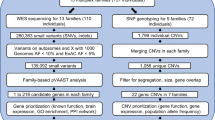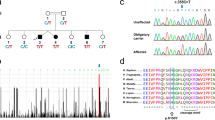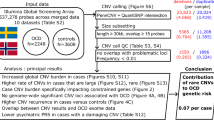Abstract
The recent finding that the neuronal cadherin gene CDH2 confers a highly significant risk for canine compulsive disorder led us to investigate whether missense variants within the human ortholog CDH2 are associated with altered susceptibility to obsessive-compulsive disorder (OCD), Tourette disorder (TD) and related disorders. Exon resequencing of CDH2 in 320 individuals identified four non-synonymous single-nucleotide variants, which were subsequently genotyped in OCD probands, Tourette disorder probands and relatives, and healthy controls (total N=1161). None of the four variants was significantly associated with either OCD or TD. One variant, N706S, was found only in the OCD/TD groups, but not in controls. By examining clinical data, we found there were significant TD-related phenotype differences between those OCD probands with and without the N845S variant with regard to the co-occurrence of TD (Fisher’s exact test P=0.014, OR=6.03). Both N706S and N845S variants conferred reduced CDH2 protein expression in transfected cells. Although our data provide no overall support for association of CDH2 rare variants in these disorders considered as single entities, the clinical features and severity of probands carrying the uncommon non-synonymous variants suggest that CDH2, along with other cadherin and cell adhesion genes, is an interesting gene to pursue as a plausible contributor to OCD, TD and related disorders with repetitive behaviors, including autism spectrum disorders.
Similar content being viewed by others
Log in or create a free account to read this content
Gain free access to this article, as well as selected content from this journal and more on nature.com
or
References
Hettema JM, Neale MC, Kendler KS : A review and meta-analysis of the genetic epidemiology of anxiety disorders. Am J Psychiatry 2001; 158: 1568–1578.
Pauls DL : The genetics of obsessive-compulsive disorder: a review. Dialogues Clin Neurosci 2010; 12: 149–163.
Rasmussen SA, Tsuang MT : The epidemiology of obsessive compulsive disorder. J Clin Psychiatry 1984; 45: 450–457.
Worbe Y, Mallet L, Golmard JL et al: Repetitive behaviours in patients with Gilles de la Tourette syndrome: tics, compulsions, or both? PLoS One 2010; 5: e12959.
Felling RJ, Singer HS : Neurobiology of tourette syndrome: current status and need for further investigation. J Neurosci 2011; 31: 12387–12395.
Mathews CA, Grados MA : Familiality of Tourette syndrome, obsessive-compulsive disorder, and attention-deficit/hyperactivity disorder: heritability analysis in a large sib-pair sample. J Am Acad Child Adolesc Psychiatry 2011; 50: 46–54.
Shmelkov SV, Hormigo A, Jing D et al: Slitrk5 deficiency impairs corticostriatal circuitry and leads to obsessive-compulsive-like behaviors in mice. Nat Med 2010; 16: 598–602, 591p following 602.
Welch JM, Lu J, Rodriguiz RM et al: Cortico-striatal synaptic defects and OCD-like behaviours in Sapap3-mutant mice. Nature 2007; 448: 894–900.
Taylor JL, Rajbhandari AK, Berridge KC, Aldridge JW : Dopamine receptor modulation of repetitive grooming actions in the rat: potential relevance for Tourette syndrome. Brain Res 2011; 1322: 92–101.
Swerdlow NR, Sutherland AN : Preclinical models relevant to Tourette syndrome. Adv Neurol 2006; 99: 69–88.
Dodman NH, Karlsson EK, Moon-Fanelli A et al: A canine chromosome 7 locus confers compulsive disorder susceptibility. Mol Psychiatry 2010; 15: 8–10.
Overall KL, Dunham AE : Clinical features and outcome in dogs and cats with obsessive-compulsive disorder: 126 cases (1989–2000). J Am Vet Med Assoc 2002; 221: 1445–1452.
Moon-Fanelli AA, Dodman NH, Famula TR, Cottam N : Characteristics of compulsive tail chasing and associated risk factors in Bull Terriers. J Am Vet Med Assoc 2011; 238: 883–889.
Goodwin M, Yap AS : Classical cadherin adhesion molecules: coordinating cell adhesion, signaling and the cytoskeleton. J Mol Histol 2004; 35: 839–844.
Shapiro L, Love J, Colman DR : Adhesion molecules in the nervous system: structural insights into function and diversity. Annu Rev Neurosci 2007; 30: 451–474.
Suriano G, Seixas S, Rocha J, Seruca R : A model to infer the pathogenic significance of CDH1 germline missense variants. J Mol Med 2006; 84: 1023–1031.
Reichardt LF : N-cadherin and integrins: two receptor systems that mediate neuronal process outgrowth on astrocyte surfaces. Neuron 2008; 60: 398–399.
Kroisel PM, Windpassinger C, Wagner K et al: De novo translocation t(5;18)(q33.1;q12.1) associated with autistic disorder. Am J Med Genet A 2004; 129A: 98–100.
Pagnamenta AT, Khan H, Walker S et al: Rare familial 16q21 microdeletions under a linkage peak implicate cadherin 8 (CDH8) in susceptibility to autism and learning disability. J Med Genet 2010.
Wang K, Zhang H, Ma D et al: Common genetic variants on 5p14.1 associate with autism spectrum disorders. Nature 2009; 459: 528–533.
Wendland JR, DeGuzman TB, McMahon F, Rudnick G, Detera-Wadleigh SD, Murphy DL : SERT Ileu425Val in autism, Asperger syndrome and obsessive-compulsive disorder. Psychiatr Genet 2008; 18: 31–39.
Wendland JR, Kruse MR, Cromer KR, Murphy DL : A large case–control study of common functional SLC6A4 and BDNF variants in obsessive-compulsive disorder. Neuropsychopharmacology 2007; 32: 2543–2551.
Heiman GA, King RA, Tischfield JA : New Jersey Center for Tourette Syndrome sharing repository: methods and sample description. BMC Med Genomics 2008; 1: 58.
Wendland JR, Kruse MR, Murphy DL : Functional SLITRK1 var321, varCDfs and SLC6A4 G56A variants and susceptibility to obsessive-compulsive disorder. Mol Psychiatry 2006; 11: 802–804.
Biesecker LG, Mullikin JC, Facio FM et al: The ClinSeq Project: piloting large-scale genome sequencing for research in genomic medicine. Genome Res 2009; 19: 1665–1674.
Ferrer-Costa C, Gelpi JL, Zamakola L, Parraga I, de la Cruz X, Orozco M : PMUT: a web-based tool for the annotation of pathological mutations on proteins. Bioinformatics 2005; 21: 3176–3178.
Kobielak A, Fuchs E : Alpha-catenin: at the junction of intercellular adhesion and actin dynamics. Nat Rev Mol Cell Biol 2004; 5: 614–625.
Shapiro L, Weis WI : Structure and biochemistry of cadherins and catenins. Cold Spring Harb Perspect Biol 2009; 1: a003053.
Bozdagi O, Wang XB, Nikitczuk JS et al: Persistence of coordinated long-term potentiation and dendritic spine enlargement at mature hippocampal CA1 synapses requires N-cadherin. J Neurosci 2010; 30: 9984–9989.
Kawauchi T, Sekine K, Shikanai M et al: Rab GTPases-dependent endocytic pathways regulate neuronal migration and maturation through N-cadherin trafficking. Neuron 2010; 67: 588–602.
Tanaka H, Shan W, Phillips GR et al: Molecular modification of N-cadherin in response to synaptic activity. Neuron 2000; 25: 93–107.
Nuriya M, Huganir RL : Regulation of AMPA receptor trafficking by N-cadherin. J Neurochem 2006; 97: 652–661.
Jensen LJ, Kuhn M, Stark M et al: STRING 8 – a global view on proteins and their functional interactions in 630 organisms. Nucleic Acids Res 2009; 37: D412–D416.
Hirano S, Kimoto N, Shimoyama Y, Hirohashi S, Takeichi M : Identification of a neural alpha-catenin as a key regulator of cadherin function and multicellular organization. Cell 1992; 70: 293–301.
Nagafuchi A, Takeichi M : Cell binding function of E-cadherin is regulated by the cytoplasmic domain. EMBO J 1988; 7: 3679–3684.
Oyama T, Kanai Y, Ochiai A et al: A truncated beta-catenin disrupts the interaction between E-cadherin and alpha-catenin: a cause of loss of intercellular adhesiveness in human cancer cell lines. Cancer Res 1994; 54: 6282–6287.
Ozawa M, Kemler R : Altered cell adhesion activity by pervanadate due to the dissociation of alpha-catenin from the E-cadherin.catenin complex. J Biol Chem 1998; 273: 6166–6170.
Shimoyama Y, Nagafuchi A, Fujita S et al: Cadherin dysfunction in a human cancer cell line: possible involvement of loss of alpha-catenin expression in reduced cell–cell adhesiveness. Cancer Res 1992; 52: 5770–5774.
Watabe M, Nagafuchi A, Tsukita S, Takeichi M : Induction of polarized cell–cell association and retardation of growth by activation of the E-cadherin–catenin adhesion system in a dispersed carcinoma line. J Cell Biol 1994; 127: 247–256.
Takeichi M : The cadherins: cell–cell adhesion molecules controlling animal morphogenesis. Development 1988; 102: 639–655.
Huber O, Kemler R, Langosch D : Mutations affecting transmembrane segment interactions impair adhesiveness of E-cadherin. J Cell Sci 1999; 112 (Part 23): 4415–4423.
Reiss K, Maretzky T, Ludwig A et al: ADAM10 cleavage of N-cadherin and regulation of cell–cell adhesion and beta-catenin nuclear signalling. EMBO J 2005; 24: 742–752.
Uemura K, Kihara T, Kuzuya A et al: Characterization of sequential N-cadherin cleavage by ADAM10 and PS1. Neurosci Lett 2006; 402: 278–283.
Dibbens LM, Tarpey PS, Hynes K et al: X-linked protocadherin 19 mutations cause female-limited epilepsy and cognitive impairment. Nat Genet 2008; 40: 776–781.
Morrow EM, Yoo SY, Flavell SW et al: Identifying autism loci and genes by tracing recent shared ancestry. Science 2008; 321: 218–223.
Soronen P, Ollila HM, Antila M et al: Replication of GWAS of bipolar disorder: association of SNPs near CDH7 with bipolar disorder and visual processing. Mol Psychiatry 2010; 15: 4–6.
Durand CM, Kappeler C, Betancur C et al: Expression and genetic variability of PCDH11Y, a gene specific to Homo sapiens and candidate for susceptibility to psychiatric disorders. Am J Med Genet B 2006; 141B: 67–70.
Giouzeli M, Williams NA, Lonie LJ, DeLisi LE, Crow TJ : ProtocadherinX/Y, a candidate gene-pair for schizophrenia and schizoaffective disorder: a DHPLC investigation of genomic sequence. Am J Med Genet B 2004; 129B: 1–9.
Lachman HM, Petroulo OA, Pedrosa E, Novak T, Nolan K, Stopkova P : Analysis of protocadherin alpha gene deletion variant in bipolar disorder and schizophrenia. Psychiatr Genet 2008; 18: 110–115.
Pedrosa E, Stefanescu R, Margolis B et al: Analysis of protocadherin alpha gene enhancer polymorphism in bipolar disorder and schizophrenia. Schizophr Res 2008; 102: 210–219.
Vincent JB, Noor A, Windpassinger C et al: Characterization of a de novo translocation t(5;18)(q33.1;q12.1) in an autistic boy identifies a breakpoint close to SH3TC2, ADRB2, and HTR4 on 5q, and within the desmocollin gene cluster on 18q. Am J Med Genet B 2009; 150B: 817–826.
Cherlyn SY, Woon PS, Liu JJ, Ong WY, Tsai GC, Sim K : Genetic association studies of glutamate, GABA and related genes in schizophrenia and bipolar disorder: a decade of advance. Neurosci Biobehav Rev 2010; 34: 958–977.
Ivleva EI, Morris DW, Moates AF, Suppes T, Thaker GK, Tamminga CA : Genetics and intermediate phenotypes of the schizophrenia – bipolar disorder boundary. Neurosci Biobehav Rev 2010; 34: 897–921.
Johnson C, Drgon T, McMahon FJ, Uhl GR : Convergent genome wide association results for bipolar disorder and substance dependence. Am J Med Genet B 2009; 150B: 182–190.
Maier W : Common risk genes for affective and schizophrenic psychoses. Eur Arch Psychiatry Clin Neurosci 2008; 258 (Suppl 2): 37–40.
Lasky-Su J, Neale BM, Franke B et al: Genome-wide association scan of quantitative traits for attention deficit hyperactivity disorder identifies novel associations and confirms candidate gene associations. Am J Med Genet B 2008; 147B: 1345–1354.
Terracciano A, Sanna S, Uda M et al: Genome-wide association scan for five major dimensions of personality. Mol Psychiatry 2010; 15: 647–656.
Redies C, Hertel N, Hubner CA : Cadherins and neuropsychiatric disorders. Brain Res 2012; 1470: 130–144.
Berx G, van Roy F : Involvement of members of the cadherin superfamily in cancer. Cold Spring Harb Perspect Biol 2009; 1: a003129.
Guilford P, Humar B, Blair V : Hereditary diffuse gastric cancer: translation of CDH1 germline mutations into clinical practice. Gastric Cancer 2010; 13: 1–10.
Liu ZJ, Xiao M, Balint K et al: Notch1 signaling promotes primary melanoma progression by activating mitogen-activated protein kinase/phosphatidylinositol 3-kinase-Akt pathways and up-regulating N-cadherin expression. Cancer Res 2006; 66: 4182–4190.
Qi J, Chen N, Wang J, Siu CH : Transendothelial migration of melanoma cells involves N-cadherin-mediated adhesion and activation of the beta-catenin signaling pathway. Mol Biol Cell 2005; 16: 4386–4397.
Nakajima S, Doi R, Toyoda E et al: N-cadherin expression and epithelial–mesenchymal transition in pancreatic carcinoma. Clin Cancer Res 2004; 10: 4125–4133.
Altshuler D, Durbin RM, Abecasis GR et al: A map of human genome variation from population-scale sequencing. Nature 2010; 467: 1061–1073.
Murphy DL, Moya PR, Wendland JR, Timpano KR : Genetic Contributions to Obsessive-Compulsive Disorder (OCD) and OCD-Related Disorders. Cambridge, UK: Cambridge University Press, 2012.
Acknowledgements
We are indebted to Diane Kazuba and Brenda Justement for conducting proband interviews, to Teresa Tolliver and Su-Jan Huang for excellent technical assistance in DNA extraction and general lab assistance and to Theresa DeGuzman for development of the OCD phenotype database and editing and graphical assistance with this manuscript. GA Heiman, RA King and JA Tischfield are supported by grants from the New Jersey Center for Tourette Syndrome and Associated Disorders and NIMH (R01MH092293). Support for the experimental studies was from the NIMH Intramural Research Program and a grant from the Simons Foundation (LF Reichardt).
Author information
Authors and Affiliations
Corresponding author
Ethics declarations
Competing interests
JRW is a Senior Principal Scientist, Pharma Research and Early Development at F Hoffmann-La Roche Ltd. None of the other authors has anything to disclose.
Additional information
Supplementary Information accompanies the paper on European Journal of Human Genetics website
Rights and permissions
About this article
Cite this article
Moya, P., Dodman, N., Timpano, K. et al. Rare missense neuronal cadherin gene (CDH2) variants in specific obsessive-compulsive disorder and Tourette disorder phenotypes. Eur J Hum Genet 21, 850–854 (2013). https://doi.org/10.1038/ejhg.2012.245
Received:
Revised:
Accepted:
Published:
Issue date:
DOI: https://doi.org/10.1038/ejhg.2012.245
Keywords
This article is cited by
-
Possible actions of cannabidiol in obsessive-compulsive disorder by targeting the WNT/β-catenin pathway
Molecular Psychiatry (2022)
-
CDH2 mutation affecting N-cadherin function causes attention-deficit hyperactivity disorder in humans and mice
Nature Communications (2021)
-
Bayesian localization of CNV candidates in WGS data within minutes
Algorithms for Molecular Biology (2019)
-
Tetrahelical structural family adopted by AGCGA-rich regulatory DNA regions
Nature Communications (2017)
-
Disruption of Ninjurin1 Leads to Repetitive and Anxiety-Like Behaviors in Mice
Molecular Neurobiology (2017)



